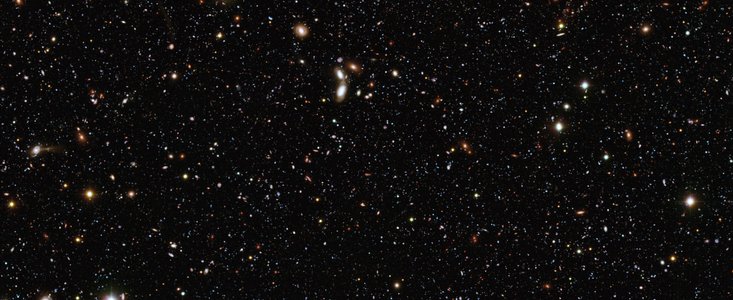Pressemitteilung
A Pool of Distant Galaxies – the deepest ultraviolet image of the Universe yet
7. November 2008
Anyone who has wondered what it might be like to dive into a pool of millions of distant galaxies of different shapes and colours, will enjoy the latest image released by ESO. Obtained in part with the Very Large Telescope, the image is the deepest ground-based U-band image of the Universe ever obtained. It contains more than 27 million pixels and is the result of 55 hours of observations with the VIMOS instrument.
This uniquely beautiful patchwork image, with its myriad of brightly coloured galaxies, shows the Chandra Deep Field South (CDF-S), arguably the most observed and best studied region in the entire sky. The CDF-S is one of the two regions selected as part of the Great Observatories Origins Deep Survey (GOODS), an effort of the worldwide astronomical community that unites the deepest observations from ground- and space-based facilities at all wavelengths from X-ray to radio. Its primary purpose is to provide astronomers with the most sensitive census of the distant Universe to assist in their study of the formation and evolution of galaxies.
The new image released by ESO combines data obtained with the VIMOS instrument in the U- and R-bands, as well as data obtained in the B-band with the Wide-Field Imager (WFI) attached to the 2.2 m MPG/ESO telescope at La Silla, in the framework of the GABODS survey.
The newly released U-band image – the result of 40 hours of staring at the same region of the sky and just made ready by the GOODS team – is the deepest image ever taken from the ground in this wavelength domain. At these depths, the sky is almost completely covered by galaxies, each one, like our own galaxy, the Milky Way, home of hundreds of billions of stars.
Galaxies were detected that are a billion times fainter than the unaided eye can see and over a range of colours not directly observable by the eye. This deep image has been essential to the discovery of a large number of new galaxies that are so far away that they are seen as they were when the Universe was only 2 billion years old.
In this sea of galaxies – or island universes as they are sometimes called – only a very few stars belonging to the Milky Way are seen. One of them is so close that it moves very fast on the sky. This "high proper motion star" is visible to the left of the second brightest star in the image. It appears as a funny elongated rainbow because the star moved while the data were being taken in the different filters over several years.
Endnoten
Because the Universe looks the same in all directions, the number, types and distribution of galaxies is the same everywhere. Consequently, very deep observations of the Universe can be performed in any direction. A series of fields were selected where no foreground object could affect the deep space observations (such as a bright star in our galaxy, or the dust from our Solar System). These fields have been observed using a number of telescopes and satellites, so as to collect information at all possible wavelengths, and characterise the full spectrum of the objects in the field. The data acquired from these deep fields are normally made public to the whole community of astronomers, constituting the basis for large collaborations.
Observations in the U-band, that is, at the boundary between visible light and ultraviolet are challenging: the Earth's atmosphere becomes more and more opaque out towards the ultraviolet, a useful property that protects people's skin, but limiting to ground-based telescopes. At shorter wavelengths, observations can only be done from space, using, for example, the Hubble Space Telescope. On the ground, only the very best sites, such as ESO's Paranal Observatory in the Atacama Desert, can perform useful observations in the U-band. Even with the best atmospheric conditions, instruments are at their limit at these wavelengths: the glass of normal lenses transmits less UV light, and detectors are less sensitive, so only instruments designed for UV observations, such as VIMOS on ESO's Very Large Telescope, can get enough light.
The VIMOS U-band image, which was obtained as part of the ESO/GOODS public programme, is based on 40 hours of observations with the VLT. The VIMOS R-band image was obtained co-adding a large number of archival images totaling 15 hours of exposure. The WFI B-band image is part of the GABODS survey.
Kontaktinformationen
Henri Boffin
ESO
Garching, Germany
Tel: +49 89 3200 6222
E-Mail: hboffin@eso.org
Valentina Rodriguez
ESO
Chile
Tel: +56 2 463 3123
E-Mail: vrodrigu@eso.org
Über die Pressemitteilung
| Pressemitteilung Nr.: | eso0839 |
| Legacy ID: | PR 39/08 |
| Name: | Chandra Deep Field South |
| Typ: | Early Universe : Galaxy |
| Facility: | MPG/ESO 2.2-metre telescope, Very Large Telescope |
| Instruments: | VIMOS, WFI |

